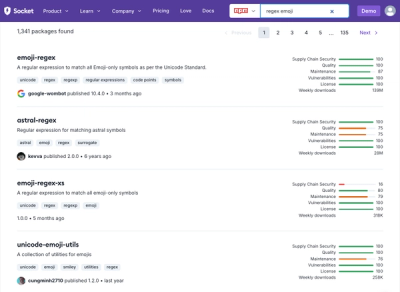
Research
Security News
Malicious npm Package Targets Solana Developers and Hijacks Funds
A malicious npm package targets Solana developers, rerouting funds in 2% of transactions to a hardcoded address.
react-dyn-tabs
Advanced tools
Create responsive and dynamic tabs in React. This library supports ARIA accessibility and provides complete control over tab management using hooks.
Create responsive and dynamic tabs in React. This library supports ARIA accessibility and provides complete control over tab management using hooks.
more button) $ npm install react-dyn-tabs --save
or
$ yarn add react-dyn-tabs
If you need to directly include script in your html, use the following link :
<script src="https://unpkg.com/react-dyn-tabs@latest/dist/react-dyn-tabs.umd.min.js"></script>
[TabList, PanelList, ready] = useDynTabs(initialOptions, plugins);
import React from 'react';
import 'react-dyn-tabs/style/react-dyn-tabs.css'; // Mandatory CSS required by the react-dyn-tabs
import 'react-dyn-tabs/themes/react-dyn-tabs-card.css'; // Optional Theme applied to the react-dyn-tabs
import useDynTabs from 'react-dyn-tabs';
const initialOptions = {
tabs: [
{
id: '1',
title: 'tab 1',
panelComponent: (props) => <p> panel 1 </p>,
},
{
id: '2',
title: 'tab 2',
panelComponent: (props) => <p> panel 2 </p>,
},
],
selectedTabID: '1',
};
export default () => {
const [TabList, PanelList] = useDynTabs(initialOptions);
return (
<div>
<TabList></TabList>
<PanelList></PanelList>
</div>
);
};
import React from 'react';
import 'react-dyn-tabs/style/scss/react-dyn-tabs.scss';
import 'react-dyn-tabs/themes/scss/react-dyn-tabs-card.scss';
import useDynTabs from 'react-dyn-tabs';
const initialOptions = {
tabs: [
{
id: '1',
title: 'tab1',
panelComponent: (props) => <p> panel 1 </p>,
},
{
id: '2',
title: 'tab2',
panelComponent: (props) => <p> panel 2 </p>,
},
],
selectedTabID: '1',
};
export default () => {
const [TabList, PanelList, ready] = useDynTabs(initialOptions);
const addTab3 = function () {
// use ready function to access the instance object
ready((instance) => {
// open tab 3
instance.open({id: '3', title: 'Tab 3', panelComponent: (props) => <p> panel 3 </p>}).then(() => {
console.log('tab 3 is open');
});
// switch to tab 3
instance.select('3').then(() => {
console.log('tab 3 is selected');
});
});
};
return (
<div>
<button onClick={addTab3}>Add tab 3</button>
<TabList></TabList>
<PanelList></PanelList>
</div>
);
};
The ready function in the react-dyn-tabs library is part of the array returned by the useDynTabs hook, alongside the TabList and PanelList components. This function allows developers to execute a callback when the TabList and PanelList components are fully mounted, providing access to the instance object for further manipulation.
ready function multiple times without any issues.ready function remains stable across component re-renders, ensuring consistent behavior.ready function is called after the tabs have already been mounted, the provided callback will be executed immediately.const [TabList, PanelList, ready] = useDynTabs(initialOptions);
const addTab3 = function () {
ready((instance) => {
// open tab 3
instance.open({id: '3', title: 'Tab 3', panelComponent: (props) => <p> panel 3 </p>}).then(() => {
console.log('tab 3 is open');
});
// switch to tab 3
instance.select('3').then(() => {
console.log('tab 3 is selected');
});
});
};
| type | default value | required | description |
|---|---|---|---|
|
Array of tabData | [] | false | initial opened tabs |
Example
const [TabList, PanelList, ready] = useDynTabs({
tabs: [
{
id: '1',
title: 'home',
iconClass: 'fa fa-home',
closable: true,
panelComponent: (props) => <p> home content </p>,
},
{
id: '2',
title: 'contact',
tooltip: 'contact',
disable: true,
closable: false,
panelComponent: (props) => <p> contact content </p>,
},
],
});
| type | default value | required | description |
|---|---|---|---|
| string | ' ' | false | specifies initial selected tab |
Example
const [TabList, PanelList, ready] = useDynTabs({
tabs: [
{
id: '1',
title: 'home',
iconClass: 'fa fa-home',
closable: true,
panelComponent: (props) => <p> home content </p>,
},
{
id: '2',
title: 'contact',
tooltip: 'contact',
disable: true,
closable: false,
panelComponent: (props) => <p> contact content </p>,
},
],
selectedTabID: '2',
});
| type | default value | required | description |
|---|---|---|---|
| string | 'ltr' | false | can be either of 'ltr' or 'rtl' |
Example
const [TabList, PanelList, ready] = useDynTabs({direction: 'rtl'});
| type | required | description |
|---|---|---|
| React component | false | custom tab component |
Example
const [TabList, PanelList, ready] = useDynTabs({
tabComponent: (props) => {
const {id, isSelected, api: instance} = props;
return (
<button {...props.tabProps}>
{props.children}
{props.iconProps && <span {...props.iconProps}></span>}
</button>
);
},
});
Default value for panelComponent option.
| type | required | description |
|---|---|---|
| React component | React element | false |
Example
const [TabList, PanelList, ready] = useDynTabs({
defaultPanelComponent: (props) => {
const {id, isSelected, api: instance} = props;
return <div>loading...</div>;
},
});
| type | default value | required | description |
|---|---|---|---|
| boolean | true | false |
Example
const [TabList, PanelList, ready] = useDynTabs({accessibility: false});
NOTE :
When accessibility option is true, it sets the id attribute of panel and button elements.
| type | default value | required | description |
|---|---|---|---|
| boolean | false | false |
Example
const [TabList, PanelList, ready] = useDynTabs({isVertical: true});
| type | required | description |
|---|---|---|
| string | no | the chosen theme name when you have multiple themes CSS. |
Examples
in this exmaple, only bootstrap theme is applied to the Tablist, because value of theme option is bootstrap
import 'react-dyn-tabs/themes/react-dyn-tabs-card.css';
import 'react-dyn-tabs/themes/react-dyn-tabs-bootstrap.css';
import 'react-dyn-tabs/themes/react-dyn-tabs-classic.css';
import 'react-dyn-tabs/themes/react-dyn-tabs-basic.css';
...
useDynTabs({theme:'bootstrap'});
in this exmaple, only classic theme is applied to the Tablist, because value of theme option is classic
import 'react-dyn-tabs/themes/react-dyn-tabs-card.css';
import 'react-dyn-tabs/themes/react-dyn-tabs-bootstrap.css';
import 'react-dyn-tabs/themes/react-dyn-tabs-classic.css';
import 'react-dyn-tabs/themes/react-dyn-tabs-basic.css';
...
useDynTabs({theme:'classic'});
If the theme option is not provided then all imported themes CSS will be applied to the Tablist.
If the theme option is set to a empty string then imported themes CSS will not be applied to the Tablist.
You can create your own theme CSS and set the theme option to your theme class name
| type | default value | required | description |
|---|---|---|---|
| object | {} | no | sets the style object for root element of Tablist |
Example
const [TabList, PanelList, ready] = useDynTabs({
tablistStyle: {backgroundColor: 'blue'},
});
| type | required | description |
|---|---|---|
| function | false | This event is fired only once, when Tabs are mounted |
Example
const [TabList, PanelList, ready] = useDynTabs({
onLoad: function () {
console.log('[onLoad]');
},
});
NOTE :
You can use this keyword inside all callback options. It refers to the instance object.
| type | required | description |
|---|---|---|
| function | false | This event is triggered after every render. |
Example
const [TabList, PanelList, ready] = useDynTabs({
onInit: function () {
console.log('[onInit]');
},
});
NOTE :
Do not use setState inside the onInit callback because it leads to an infinite loop.
| type | required | description |
|---|---|---|
| function | false | fires when we open|close|select a tab. this event is not fired initially |
Example
const [TabList, PanelList, ready] = useDynTabs({
onChange: function ({currentData, previousData, closedTabIDs, openedTabIDs}) {
console.log('[onChange]');
},
});
| type | required | description |
|---|---|---|
| function | false | Fires when the user clicks on the tab, but before select them. This event should return boolean true or false, If the event returns false the tab is not selected. |
Example
const [TabList, PanelList, ready] = useDynTabs({
beforeSelect: function (e, id) {
console.log('[beforeSelect]');
return true;
},
});
| type | required | description |
|---|---|---|
| function | false | fires after selecting a tab for the first time. It is not fired for the initial selected tab |
Example
const [TabList, PanelList, ready] = useDynTabs({
onFirstSelect: function ({currentSelectedTabId, previousSelectedTabId}) {
console.log('[onFirstSelect]');
},
});
| type | required | description |
|---|---|---|
| function | false | fires after selecting a tab. this event is not fired for the initial selected tab |
Example
const [TabList, PanelList, ready] = useDynTabs({
onSelect: function ({currentSelectedTabId, previousSelectedTabId}) {
console.log('[onSelect]');
},
});
| type | required | description |
|---|---|---|
| function | false | fires after opening tabs. this event is not fired for initial opened tabs |
Example
const [TabList, PanelList, ready] = useDynTabs({
onOpen: function (openedTabIDs) {
console.log('[onOpen]');
},
});
| type | required | description |
|---|---|---|
| function | false | fires when the user clicks on the close icon, but before close them. This event should return boolean true or false, If the event return false the tab is not closed. |
Example
const [TabList, PanelList, ready] = useDynTabs({
beforeClose: function (e, id) {
console.log('[beforeClose]');
return true;
},
});
| type | required | description |
|---|---|---|
| function | false | fires after closing tabs |
Example
const [TabList, PanelList, ready] = useDynTabs({
onClose: function (closedTabIDs) {
console.log('[onClose]');
},
});
| type | required | description |
|---|---|---|
| function | false | fires before destroying useDynTabs hook |
Example
const [TabList, PanelList, ready] = useDynTabs({
onDestroy: function () {
console.log('[onDestroy]');
},
});
Return value : boolean
Parameters:
id: StringExample
const result = instance.isOpen('Your tab ID');
Triggers onInit, onChange and onOpen events.
It only triggers onInit event, if the tab is already open.
Return value : Promise
Parameters:
tabData: ObjectExample
if (instance.isOpen('contact') == false) {
instance
.open({
id: 'contact',
title: 'contact',
tooltip: 'contact',
disable: false,
closable: true,
iconClass: '',
panelComponent: <ContactPanel></ContactPanel>,
})
.then(({currentData, instance}) => {
console.log('contact tab is open');
});
}
Return value : boolean
Parameters:
id: StringExample
const result = instance.isSelected('Your tab ID');
Makes current and previous selected tab to be re-rendered
Triggers onInit, onChange and onSelect events.
It only triggers onInit event, if the tab is already selected.
Return value : Promise
Parameters:
id: stringExample
if (instance.isSelected('1') == false) {
instance.select('1').then(({currentData, instance}) => {
console.log('tab 1 is selected');
});
}
Triggers onInit, onChange and onClose events.
It only triggers onInit event, if the tab is already closed.
When switching parameter is true, it switches to previous selected tab
Return value : Promise
Parameters:
id: stringswitching: boolean (default : true)Example
if (instance.isOpen('2') == true) {
instance.close('2').then(({currentData, instance}) => {
console.log('tab 2 is closed');
});
}
Makes all tabs to be re-rendered.
triggers onInit event.
Return value : Promise
Example
instance.refresh().then(({currentData, instance}) => {});
Parameters:
optionName : StringExample
const direction = instance.getOption('direction');
const onSelect = instance.getOption('onSelect');
Can be used for setting all options except selectedTabID and tabs options.
This function does not re-render Tabs. If you need to re-render Tabs, use refresh method after this function.
Return value : instance object
Parameters:
optionName : StringoptionValue : string|boolean|object|functionExample
instance.setOption('direction', 'rtl');
instance.setOption('onSelect', () => {});
instance.setOption('beforeSelect', () => false);
Get tabData object
Return value : tabData object
Parameters:
id : StringExample
const {id, title, tooltip, disable, lazy, iconClass, closable, panelComponent} = instance.getTab('contactID');
console.log(id); //contactID
Set tabData object.
This function does not re-render Tabs. If you need to re-render Tabs, use refresh method after this function.
Return value : instance object
Parameters:
tab id : Stringsource object : containing the properties you want to applyExample
instance.setTab('home', {disable: true});
instance.setTab('contact', {closable: false, panelComponent: (props) => <p>contact panel</p>});
Attach an event handler function for one event.
Return value : instance object
Parameters:
event Name : String (can be either of onFirstSelect|onSelect|onClose|onOpen|onInit|onChange|onDestroy)handler : functionExample
const handler = React.useCallback(function (params) {
const {currentSelectedTabId, previousSelectedTabId} = params;
}, []);
instance.on('onSelect', handler);
Attach a handler to an event. The handler is executed at most once.
Return value : instance object
Parameters:
event Name : String (can be either of onFirstSelect|onSelect|onClose|onOpen|onInit|onChange|onDestroy)handler : functionExample
instance.one('onSelect', function ({currentSelectedTabId, previousSelectedTabId}) {});
Remove an event handler.
Return value : instance object
Parameters:
event Name : String (can be either of onFirstSelect|onSelect|onClose|onOpen|onInit|onChange|onDestroy)handler : function (A handler function previously attached for the event)Example
const handler = React.useCallback(function () {}, []);
const attachHandler = () => {
instance.on('onSelect', handler);
};
const deattachHandler = () => {
instance.off('onSelect', handler);
};
Get a copy of data
Return value : Data Object
Example
const {selectedTabID, openTabIDs} = instance.getData();
NOTE :
getCopyData function is an older version of getData function and it is enabled by default so that existing users do not have to change their code. You are free to use both conventions.Get a copy of data in previous render
Return value : Data Object
Example
const {selectedTabID, openTabIDs} = instance.getPreviousData();
NOTE :
getCopyPerviousData function is an older version of getPreviousData function and it is enabled by default so that existing users do not have to change their code. You are free to use both conventions.Useful for sorting Tabs manually.
Triggers onInit event.
Return value : Promise
Parameters:
Array of all Tabs IDsExample
const {openTabIDs} = instance.getData();
instance.sort(openTabIDs.reverse()).then(({currentData, instance}) => {
console.log('sorting Tabs has finished');
});
| property name | type | default value | required | description |
|---|---|---|---|---|
| id | string | false | an unique identifier for each tab | |
| title | string | ' ' | false | |
| tooltip | string | ' ' | false | |
| panelComponent | React Element | React Component | null | A function component which returns empty div | false | |
| lazy | boolean | false | false | If set to false the panel will be rendered initially. if set to true the panel will not be rendered until the tab is activated |
| closable | boolean | true | false | |
| iconClass | string | ' ' | false | class name for the icon |
| disable | boolean | false | false |
Example
const tabData = {
id: 'contactID',
title: 'contactTitle',
tooltip: 'contactTooltip',
disable: true,
lazy: true,
iconClass: 'fa fa-home',
closable: false,
panelComponent: (props) => <p> contact content </p>,
};
const [TabList, PanelList, ready] = useDynTabs({tabs: [tabData]});
// or
if (instance.isOpen(tabData.id) == false) {
instance.open(tabData).then(() => {});
}
Defer loading of tab content until the tab is activated
Example 1
const Panel3 = React.lazy(() => import('./components/panel3.js'));
function LazyLoadingPanel3(props) {
return (
<Suspense fallback={<div>Loading...</div>}>
<Panel3 {...props}></Panel3>
</Suspense>
);
}
useDynTabs({
tabs: [
{id: '1', title: 'eager loading tab 1', panelComponent: <p>panel 1</p>},
{id: '2', title: 'eager loading tab 2', lazy: true, panelComponent: <p>panel 2</p>},
{id: '3', title: 'lazy loading tab 3', lazy: true, panelComponent: LazyLoadingPanel3},
],
selectedTabID: '1',
});
NOTE :
Example 2 ( using onFirstSelect event )
useDynTabs({
tabs: [
{id: '1', title: 'eager loading tab 1', panelComponent: <p>panel 1</p>},
{id: '2', title: 'eager loading tab 2', lazy: true, panelComponent: <p>panel 2</p>},
{id: '3', title: 'lazy loading tab 3', lazy: true},
],
selectedTabID: '1',
defaultPanelComponent: function DefaultPanel() {
return <div>loading...</div>;
},
onFirstSelect: function ({currentSelectedTabId}) {
const instance = this;
if (currentSelectedTabId === '3') {
import('path to/panel3.js').then((defaultExportedModule) => {
const Panel3 = defaultExportedModule.default;
instance.setTab('3', {panelComponent: Panel3});
instance.refresh();
});
}
},
});
Make Tabs responsive
Usage
import React from 'react';
import 'react-dyn-tabs/style/react-dyn-tabs.css';
import 'react-dyn-tabs/themes/react-dyn-tabs-card.css';
import useDynTabs from 'react-dyn-tabs';
import MoreButtonPlugin from 'react-dyn-tabs/plugins/moreButtonPlugin';
export default () => {
const [TabList, PanelList, ready] = useDynTabs(initialOptions, [MoreButtonPlugin]);
return (
<div>
<TabList></TabList>
<PanelList></PanelList>
</div>
);
};
Options
| option name | type | description |
|---|---|---|
| moreButtonPlugin_buttonComponent | React Function Component | customize root component of more button |
| moreButtonPlugin_iconComponent | React Function Component | customize icon component of more button |
| moreButtonPlugin_buttonTooltip | string |
Example
useDynamicTabs(
{
tabs: [
{id: '1', title: 'tab1', panelComponent: <span>tab content 1</span>},
{id: '2', title: 'tab2', panelComponent: <span>tab content 2</span>},
{id: '3', title: 'tab3', panelComponent: <span>tab content 3</span>},
],
selectedTabID: '1',
moreButtonPlugin_iconComponent: ({instance}) => {
return <i className={`fa fa-chevron-${instance.getOption('direction') === 'rtl' ? 'left' : 'right'}`} />;
},
moreButtonPlugin_buttonTooltip: 'show more tabs',
},
[MoreButtonPlugin],
);
unpkg Link
<script src="https://unpkg.com/react-dyn-tabs@latest/dist/more-button-plugin.umd.min.js"></script>
render new tab button example :
const [TabList, PanelList, ready] = useDynTabs(initialOptions, [MoreButtonPlugin]);
return (
<div>
<TabList>
<button onClick={()=>{ ready(instance => instance.open({title:'new tab'})) }}>
NEW
</button>
</TabList>
<PanelList></PanelList>
</div>
);
};
render close all button example :
const [TabList, PanelList, ready] = useDynTabs(initialOptions, [MoreButtonPlugin]);
return (
<div>
<TabList>
<button onClick={()=>{ ready(instance=>{ instance.getData().openTabIDs.forEach(id=>instance.close(id,false)); })}}>
CLOSE ALL
</button>
</TabList>
<PanelList></PanelList>
</div>
);
};
react-dyn-tabs does not include any style loading by default. Default stylesheets and themes are provided and can be included in your application if desired.
import 'react-dyn-tabs/style/react-dyn-tabs.css';
// or import 'react-dyn-tabs/style/react-dyn-tabs.min.css';
// or import 'react-dyn-tabs/style/scss/react-dyn-tabs.scss';
For rtl mode you should also import following file
import 'react-dyn-tabs/style/react-dyn-tabs-rtl.css';
// or import 'react-dyn-tabs/style/react-dyn-tabs-rtl.min.css';
// or import 'react-dyn-tabs/style/scss/react-dyn-tabs-rtl.scss';
Themes define how the Tabs looks. The library comes with Provided Themes such as card and bootstrap. To use a theme you need to 1) import the themes CSS and 2) apply the chosen theme name to the theme option of the react-dyn-tabs.
card theme
import 'react-dyn-tabs/themes/react-dyn-tabs-card.css';
// or import 'react-dyn-tabs/themes/scss/react-dyn-tabs-card.scss';
// or import 'react-dyn-tabs/themes/react-dyn-tabs-card.min.css';
...
useDynTabs({theme:'card'});
bootstrap theme
import 'react-dyn-tabs/themes/react-dyn-tabs-bootstrap.css';
// or import 'react-dyn-tabs/themes/scss/react-dyn-tabs-bootstrap.scss';
// or import 'react-dyn-tabs/themes/react-dyn-tabs-bootstrap.min.css';
...
useDynTabs({theme:'bootstrap'});
basic theme
import 'react-dyn-tabs/themes/react-dyn-tabs-basic.css';
// or import 'react-dyn-tabs/themes/scss/react-dyn-tabs-basic.scss';
// or import 'react-dyn-tabs/themes/react-dyn-tabs-basic.min.css';
...
useDynTabs({theme:'basic'});
classic theme
import 'react-dyn-tabs/themes/react-dyn-tabs-classic.css';
// or import 'react-dyn-tabs/themes/scss/react-dyn-tabs-classic.scss';
// or import 'react-dyn-tabs/themes/react-dyn-tabs-classic.min.css';
...
useDynTabs({theme:'classic'});
Some actions like open, select, close and refresh cause re-rendering, and using them immediately after calling useDynTabs hook will create an infinite loop and other bugs that most likely you don't want to cause. you should use them inside event listeners or subscriptions.
Do not use setState inside the onInit callback because it leads to an infinite loop.
$ npm run test
MIT
FAQs
Create responsive and dynamic tabs in React. This library supports ARIA accessibility and provides complete control over tab management using hooks.
We found that react-dyn-tabs demonstrated a healthy version release cadence and project activity because the last version was released less than a year ago. It has 0 open source maintainers collaborating on the project.
Did you know?

Socket for GitHub automatically highlights issues in each pull request and monitors the health of all your open source dependencies. Discover the contents of your packages and block harmful activity before you install or update your dependencies.

Research
Security News
A malicious npm package targets Solana developers, rerouting funds in 2% of transactions to a hardcoded address.

Security News
Research
Socket researchers have discovered malicious npm packages targeting crypto developers, stealing credentials and wallet data using spyware delivered through typosquats of popular cryptographic libraries.

Security News
Socket's package search now displays weekly downloads for npm packages, helping developers quickly assess popularity and make more informed decisions.